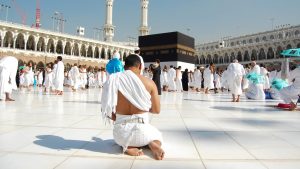WHY DO MUSLIMS PERFORM HAJJ? PURPOSE, HISTORY, RITUALS, AND SIGNIFICANCE
Hajj, the holy pilgrimage to Mecca, is one of the five fundamental pillars of Islam and a deeply revered religious duty. Each year, the Kingdom of Saudi Arabia welcomes millions of Muslims who come together in devotion to fulfill this sacred obligation.
But what motivates Muslims to undertake this journey at least once in their lifetime? How vital is Hajj in the life of a believer?
In this blog, we explore the spiritual purpose, historical roots, and religious value of Hajj. We’ll also look into the stories behind its rituals and uncover fascinating facts about this unique spiritual expedition.
What Is the Purpose of Performing Hajj?
The five pillars of Islam form the foundation of a Muslim’s faith, and Hajj stands as one of those essential obligations. It is mandatory for every physically and financially capable Muslim to perform Hajj at least once in their lifetime.
The Qur’an affirms this obligation:
“And [due] to Allah from the people is a pilgrimage to the House—for whoever is able to find thereto a way.”
(Qur’an 3:97)
At its core, the purpose of Hajj is to fulfill a divine command and draw spiritually closer to Allah. The journey is one of reflection, repentance, purification, and deep spiritual renewal.
During Hajj, Muslims from across the globe unite in the same attire, performing the same rituals, regardless of status or nationality. This powerful display of equality, humility, and unity is one of the most profound aspects of the pilgrimage.
Why Must Muslims Perform Hajj at Least Once?
The origins of Hajj trace back to Prophet Ibrahim (Abraham, peace be upon him) and his family. According to Islamic tradition, Allah commanded Prophet Ibrahim to leave his wife Hajar and son Ismail in the barren valley of Mecca. When their water ran out, Hajar ran between the hills of Safa and Marwa in search of help. In response, Allah provided the miraculous Zamzam well, which still flows today and is a sacred part of the pilgrimage.
Later, Prophet Ibrahim and his son Ismail were instructed to build the Kaaba, the House of Allah, and call people to pilgrimage.
Performing Hajj is therefore not only an act of worship but a connection to this powerful legacy of faith, sacrifice, and obedience.
Why Is Hajj Performed Only Once a Year?
Hajj is performed exclusively during the Islamic month of Dhul-Hijjah, the 12th month of the lunar calendar. These days hold deep religious significance as they correspond with the moments when Prophet Ibrahim was tested by Allah and showed complete obedience.
By having Hajj at a fixed time each year, the pilgrimage becomes a spiritually concentrated and globally unified event. This scheduling also allows Muslims time to plan and prepare for this transformative journey.
The Story Behind the 5 Days of Hajj
Hajj spans over five days and includes a series of rituals rich in spiritual and historical meaning. Here’s a brief overview of the key elements:
1. Ihram and Tawaf
-
Ihram is the state of spiritual purity that begins the pilgrimage. Pilgrims wear simple white garments symbolizing equality and humility.
-
Tawaf involves walking around the Kaaba seven times.
-
Sa’i follows, where pilgrims walk between the hills of Safa and Marwa, reenacting Hajar’s desperate search for water.
2. Day at Arafat
-
Pilgrims gather at the Plain of Arafat, where Prophet Muhammad (peace be upon him) gave his Farewell Sermon.
-
This day is dedicated to prayer, supplication, and asking Allah for forgiveness. It is considered the pinnacle of the Hajj.
3. Night at Muzdalifah and Stoning at Mina
-
Pilgrims spend the night under the open sky in Muzdalifah, collecting pebbles.
-
The next day, they go to Mina to perform the stoning of the devil (Jamarat)—a symbolic rejection of Satan’s temptation.
4. Eid al-Adha and the Sacrifice
-
Pilgrims observe Eid al-Adha, commemorating Prophet Ibrahim’s willingness to sacrifice his son.
-
An animal is sacrificed, and pilgrims shave their heads (for men) or trim their hair (for women) as a sign of renewal.
5. Farewell Tawaf
-
Before departing Mecca, pilgrims perform a final Tawaf, bidding farewell to the Kaaba and concluding their pilgrimage.
Important Facts About Hajj
-
One of the World’s Largest Gatherings: Hajj is among the largest annual religious gatherings globally, often drawing over 2 million pilgrims.
-
A Symbol of Universal Equality: All pilgrims wear white garments, erasing distinctions of wealth, nationality, or social status.
-
Spiritual Cleansing: Hajj is believed to purify the soul, with the Prophet (PBUH) saying a sincere Hajj leaves one as sin-free as a newborn.
-
Historical Significance: Every ritual connects back to Prophet Ibrahim, Hajar, and Ismail, keeping their legacy alive through devotion and remembrance.
Conclusion
Hajj is more than just a physical journey—it’s a spiritual transformation, a connection to Islamic history, and a living symbol of unity and submission to Allah. From the stories of sacrifice to the rituals of prayer and devotion, every step of Hajj reminds Muslims of their purpose, faith, and the eternal bond between Creator and creation.
For those who are able, performing Hajj even once in a lifetime is not only a religious duty—it is a profound privilegeand a life-changing experience.


